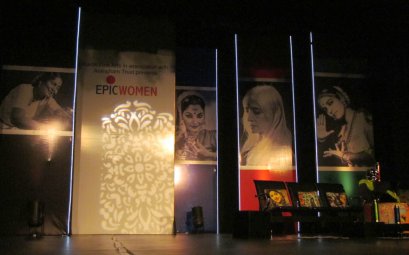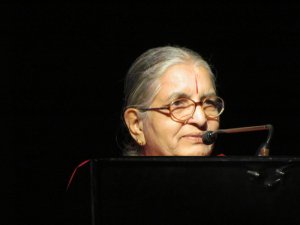
|   |

|   |
Natya Darshan Seminar EPIC WOMEN - Conference / Performance conclave DAY 1 - Epic Women of the Epics - Kiran Rajagopalan e-mail: kiran.rajagopalan@gmail.com Photos: Lalitha Venkat December 21, 2012 Bharatiya Vidya Bhavan resonated with the auspicious vibrations of drums, deftly played by Adishakti drummers from Pondicherry, at the start of the inaugural day of ‘Epic Women.’ They performed Ardhakunjanarishwara from their larger work 'Ganapati,' accommodating the female element of Ganapati, the deity of auspicious beginnings." While the stage was being readied, Sudharani Raghupathy and Chitra Visweswaran reminisced about the first ‘Natya Darshan’ conference in 2001, which was dedicated to Maratha King Serfoji II’s singular contribution to classical art.
Convener Dr. Anita Ratnam then gave a brief introduction and unveiled part of designer Rex’s modern stage set with sleek black couches and colorful pillows with images of iconic women. After the inaugural address by Kartik Fine Arts Chairman, L. Sabaretnam, a second surprise unveiling revealed four illuminated images of legendary dancers Balasaraswati, Chandralekha, Indrani Rehman, and Rukmini Devi Arundale! The keynote address was delivered by Dr. Prema Nandakumar, and her lucid discussion on the relevance of Hindu mythology’s epic women turned into a witty satire of arranged marriages in India.  Stage  Sudharma Vaithiyanathan (Photo: Vipul Sangoi)  Dr. Prema Nandakumar  Dr. Swarnamalya Ganesh The conference began with an engaging presentation by Dr. Swarnamalya Ganesh on the depiction of women in Sangam literature. Focusing mainly on the Tamil epic poems Silapadikkaram and Manimekalai, Dr. Ganesh examined how Kannagi, Madhavi, and Manimekalai were powerful agents of change even while being subjected to the conventions imposed by the social systems they lived in. For example, she hypothesized that Madhavi made the conscious decision to become a Buddhist ascetic based on the fact that she was extremely well-read (as befitting a courtesan of that time). Dr. Ganesh also revealed several other striking parallels between these three characters and various female deities worshipped during the Sangam period. The second session began with a Bharatanatyam performance by 18-year old Sudharma Vaithiyanathan in which she charmingly enacted the pivotal moment when Sita first sees Rama. Her performance was followed by an incisive panel presentation on Sita with Veenapani Chawla (contemporary theatre artiste), Dr. C.S. Lakshmi (research-scholar), and Kapila Venu (Nangiar Koothu artiste). All three presenters discussed Sita as a “non-gendered symbol of injustice and oppression.”
Veenapani believes that Sita must have found the rules and laws in Ayodhya stifling in stark contrast to her more liberal upbringing in Mithila. Therefore, Sita’s exile to the forest marked her “escape into freedom from oppressive civilization.” Dr. Lakshmi added that Sita rarely expresses her anguish, but her burning desire for free will is still clearly evident especially in the other versions of the Ramayana. Interestingly, Kapila revealed that Sita is a not a character that Nangiar Koothu artistes strive to depict as she is rarely seen on stage. In fact, Kapila’s initial apathy towards the character changed when she began analyzing the episode when Sita proves her chastity by stepping into the fire. Ultimately, Kapila was most influenced by Sita’s intimate relationship to the forest when she further developed the character in ‘Sita Parithyagam: The Abandonment of Sita.’ A discussion between the audience and the panelists concluded the first day. Despite the delay at the start, Dr. Ratnam judiciously ended the conference just a few minutes behind schedule. Kiran Rajagopalan is a Bharatanatyam dancer and writer. |